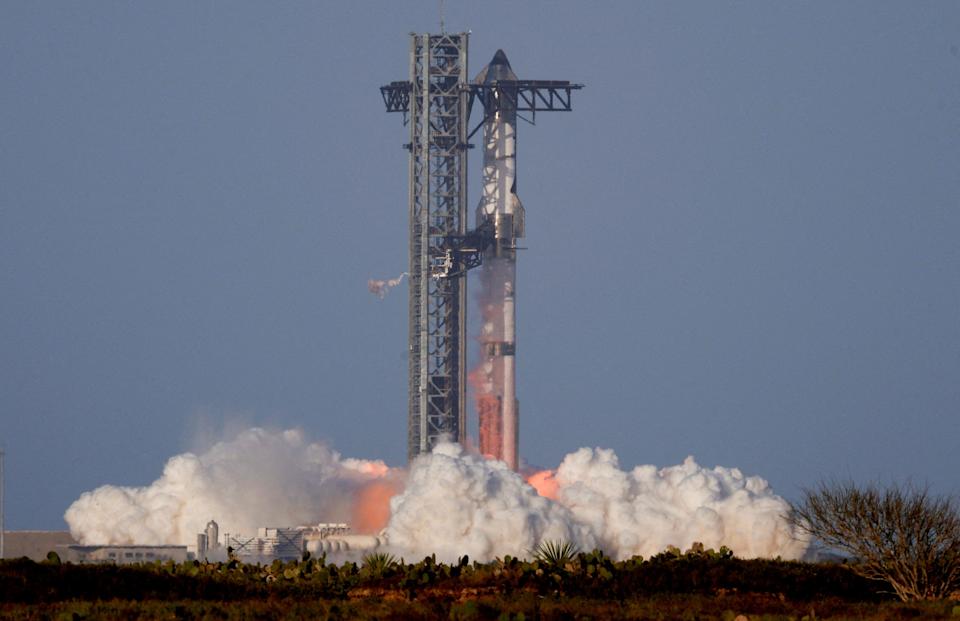Elon Musk’s SpaceX Successfully Launches Starship, Bringing Mars Dream Closer to Reality

Elon Musk’s SpaceX Successfully Launches Starship, Bringing Mars Dream Closer to Reality
Introduction: Elon Musk’s ambitious vision of making humanity a multi-planetary species just took a significant leap forward as SpaceX successfully launched its Starship rocket, a key component of Musk’s plan to colonize Mars. With the successful launch, Musk’s dream of sending humans to the Red Planet is one step closer to becoming a reality. SpaceX’s Starship is not just another rocket—it’s the cornerstone of Musk’s long-term goal of reducing space travel costs, enabling deep space exploration, and eventually establishing a sustainable human presence on Mars. This successful launch marks a critical milestone in both the development of SpaceX’s technology and humanity’s journey into the cosmos. In this article, we explore the significance of the Starship launch, the technological advancements it represents, and what it means for the future of space exploration.
Starship: The Vehicle Designed for Mars Colonization Starship is SpaceX’s next-generation spacecraft, designed to carry humans to the Moon, Mars, and beyond. What sets Starship apart from other rockets is its immense size, versatility, and reusability. Unlike traditional rockets, Starship is fully reusable, which dramatically reduces the cost of launching payloads and crew into space. Musk’s vision for Starship goes beyond simply launching satellites or resupplying the International Space Station (ISS); the spacecraft is intended to transport large numbers of passengers and cargo to other planets, particularly Mars.
The successful launch of Starship is a crucial step toward proving the feasibility of Musk’s plans for interplanetary travel. SpaceX’s development of Starship is designed to meet the rigorous demands of long-duration space missions. The rocket’s design includes features like a heat shield for re-entry, the ability to carry both crew and cargo, and the capability to land vertically, allowing for quick turnaround times between flights. With these advanced features, Starship could one day serve as the workhorse for missions to the Moon, Mars, and even the outer reaches of the solar system.
What the Successful Launch Means for SpaceX and Space Exploration The successful launch of Starship is a major victory for SpaceX, which has faced numerous challenges in its journey to develop a spacecraft capable of reaching Mars. The rocket’s development has been marked by multiple prototypes, testing phases, and numerous failures before this milestone was reached. SpaceX has taken a highly iterative approach to Starship’s development, and this success demonstrates the company’s resilience and ability to overcome challenges in its quest to make interplanetary travel a reality.
For SpaceX, the Starship launch is also a key validation of its approach to space exploration. The company’s mission has always been to reduce the cost of space travel, and the success of Starship aligns with that goal. The reusable design of the rocket, which can be launched and landed multiple times, drastically reduces the cost of accessing space. By improving the economics of space travel, SpaceX is making it possible for more people and organizations to reach space, paving the way for commercial space exploration, research, and tourism.
Moreover, the success of Starship will have far-reaching implications for the future of space exploration. Musk’s goal of establishing a human presence on Mars has long seemed like science fiction, but with the development of Starship, it is now within the realm of possibility. SpaceX’s vision for Starship is not just about reaching Mars—it’s about creating the infrastructure for humanity to live on another planet. With its ability to transport large groups of people and cargo, Starship could be the foundation for building colonies, conducting scientific research, and making Mars a second home for humanity.
The Next Steps for SpaceX and Mars Colonization While the successful launch of Starship is a major achievement, it is only the beginning of what will be a long and complex journey toward Mars colonization. There are still numerous technical challenges to overcome, including refining the spacecraft’s systems for long-duration space travel, ensuring the safety and well-being of passengers, and developing the necessary infrastructure on Mars to support human life.
One of the key next steps for SpaceX will be conducting additional test flights and refining Starship’s systems. SpaceX has already announced plans to conduct several more tests, including orbital flights and full crewed missions, which will provide valuable data to improve the spacecraft’s design and capabilities. These tests will also help SpaceX refine its launch and landing systems, ensure that Starship can perform well in a variety of space environments, and address any technical issues that arise.
In parallel, SpaceX is working on developing the necessary infrastructure for Mars colonization. This includes landing sites on Mars, habitats for astronauts, and systems for generating resources such as water, oxygen, and food. SpaceX has been collaborating with NASA and other organizations to develop the technology and expertise needed to support human life on Mars, but this will require significant investment and ongoing research.
Musk’s ultimate goal is to establish a self-sustaining colony on Mars. This means not just sending humans to the planet but ensuring that they can survive and thrive there. In the coming years, SpaceX will need to focus on developing technologies that can help humans live on Mars for extended periods, such as sustainable life support systems, efficient energy generation, and ways to produce food and water from local resources.
The Impact of Starship on the Broader Space Industry The successful launch of Starship is not only a significant moment for SpaceX, but it also has the potential to transform the entire space industry. The development of a fully reusable spacecraft capable of carrying humans and cargo to other planets could change the way we think about space exploration. Starship’s capabilities will open up new possibilities for private companies, research institutions, and governments to conduct space missions, including long-duration expeditions, lunar exploration, and Mars colonization.
Starship’s success will also have a major impact on the future of space tourism. Musk has made it clear that one of his goals is to make space accessible to everyone, and Starship could be the vehicle that makes space tourism a reality. In the coming years, it is possible that private citizens will be able to take commercial flights on Starship, traveling to space, the Moon, or even Mars. The rocket’s ability to carry large numbers of passengers and provide a comfortable, safe travel experience is key to making space tourism a viable industry.
Moreover, SpaceX’s success with Starship could inspire other companies and nations to invest more heavily in space exploration. As the cost of launching rockets decreases, more opportunities will be available for space missions, research, and development. This could lead to greater collaboration between private companies, governments, and international organizations, accelerating the pace of space exploration and increasing the number of players in the space industry.
Conclusion: Elon Musk’s SpaceX has reached a historic milestone with the successful launch of Starship, bringing his dream of Mars colonization one step closer to reality. The launch validates SpaceX’s approach to space exploration, showcasing the company’s innovative design, resilience, and ability to push the boundaries of what is possible. While there is still much work to be done, Starship represents a key piece in the puzzle of making humanity a multi-planetary species. With its advanced technology, reusability, and ability to carry both crew and cargo, Starship is set to revolutionize space exploration and help pave the way for a sustainable human presence on Mars. Musk’s vision for space is becoming increasingly attainable, and the success of Starship is a testament to the power of ambition, innovation, and relentless determination. As SpaceX continues to refine its technology and move closer to its goals, the dream of human life on Mars is no longer just a distant fantasy—it’s on the horizon.








